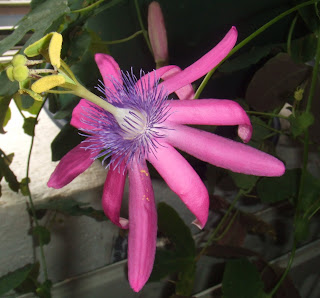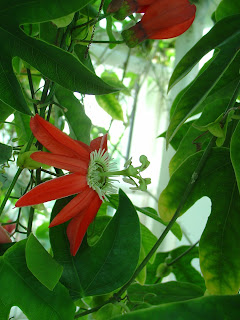I bought this under the name Passiflora 'Kew Gardens' and the first flower just opened today.
At first I thought is that it was labeled such because there was some uncertainty about its exact parentage, but appeared to the vendor to be P. x kewensis or something similar. P. x kewensis is "considered to be P. caerulea x raddiana (kermesina)" According to John Vanderplank's Passionflowers.
 |
| Passiflora x kewensis |
In Passiflora: Passionflowers of the World, Roland Fischer writes:
"Alas, many old hybrids are no longer under cultivation. In times of war, many private people have had to give up their collections, and even botanical gardens have had to cut back on costs incurred by overwintering plants in heated conservatories. A sad loss, for example, is the disappearance of Passiflora x kewensis (P. cearulea x kermesina, 1888), along with its parent plant P. kermesina. As soon as P. kermesina is reestablished in cultivation - and concerted efforts are being made to find it - Passiflora x kewensis can again be bred. In many collections, other crosses are cultivated erroneously under the name Passiflora x kewensis. A hybrid of P. racemosa is wide-spread under this name."
Later in the same book, Torsten Ulmer confirms that this species had indeed be rediscovered in Brazil and re-entered cultivation. He goes on to state that Fischer had been using it for hybridization, but makes no mention of whether x kewensis had been recreated.
Possible parents of my Passiflora 'Kew Gardens'
On my plant filaments are clear white and its balloon-like buds and thickly keeled sepals bear more than a passing resemblance to those of P. racemosa.
Further research revealed the possibility that 'Kew Gardens' is not P. x kewensis, but rather P. racemosa x P. mucronata or P. galbana.
Passiflora mucronata has thickly-keeled sepals with awns - which matches my plant, and since my plant's flowers display almost no cearulea traits, I'm inclined to believe that this final option might be the case.
Whatever its parentage, it is lovely, and as a friend pointed out has "rainbow tendrils" (see the tendril above and to the right of the flower in my picture at the top of the post). I hope it makes it through the winter outdoors in San Francisco.
Further research revealed the possibility that 'Kew Gardens' is not P. x kewensis, but rather P. racemosa x P. mucronata or P. galbana.
 |
| Passiflora mucronata -passiflora.co.uk |
Passiflora mucronata has thickly-keeled sepals with awns - which matches my plant, and since my plant's flowers display almost no cearulea traits, I'm inclined to believe that this final option might be the case.
Whatever its parentage, it is lovely, and as a friend pointed out has "rainbow tendrils" (see the tendril above and to the right of the flower in my picture at the top of the post). I hope it makes it through the winter outdoors in San Francisco.



No comments:
Post a Comment